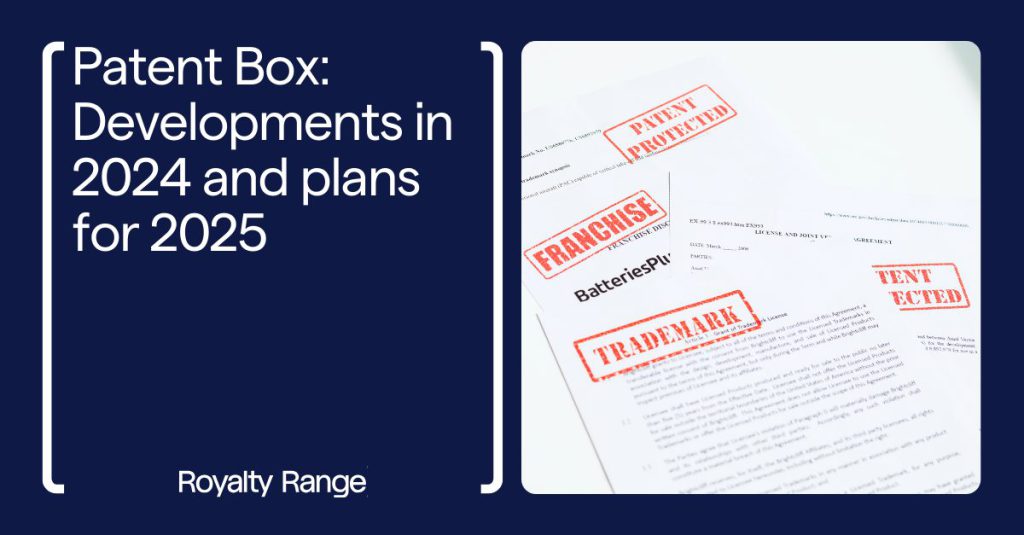Patent box developments and plans for 2025
RoyaltyRange

The Patent Box regime is a tax incentive aimed at promoting innovation by reducing the effective tax rate on income derived from intellectual property (IP), which makes it appealing for businesses aiming to maximize returns on patented inventions, copyrights, or software developments. In recent years, many countries have adopted or adjusted Patent Box regimes to encourage domestic R&D. As global tax policies shift, Patent box regimes must adapt, leading to notable developments in 2024 and strategic changes anticipated for 2025.
What is a Patent box?
A Patent box is a tax incentive regime that allows companies to apply a lower tax rate to income derived from qualifying IP, particularly patents. The goal is to encourage R&D by rewarding companies that innovate within the jurisdiction. Companies that hold patents and generate revenue from these innovations can benefit from a reduced corporate tax rate on the income linked to them, effectively lowering their tax burden on IP-derived profits.
Patent box regimes vary by country regarding qualifying IP assets, tax rate reductions, and conditions. Typically, they apply to income from patents, copyrights, and, in some cases, other IP rights like trademarks or software copyrights. However, these regimes must demonstrate a direct link, or “nexus,” between IP income and R&D conducted within the country providing the tax relief and align with the OECD’s Base Erosion and Profit Shifting (BEPS) standards, which mandate companies to perform significant R&D activities domestically to qualify, preventing tax base erosion through IP income relocation.
The benefits of a Patent box can encourage companies to invest more in innovation, leading to broader economic growth and technological advancement. However, these programs have faced careful examination and call for standardization to avoid aggressive tax planning and ensure that IP activity benefits the local economy.
Overview of 2024
In 2024, the Patent box regime continues to evolve internationally, primarily aiming to support innovation by offering tax relief on income generated from qualifying IP. This year, countries are refining their policies in response to OECD guidelines and to stay competitive in attracting R&D-intensive businesses.
For instance, the recent Patent box legislation in Hong Kong offers a 5% reduced tax rate for eligible IP income derived locally through R&D, focusing on patents and functionally similar IP. This is a significant reduction compared to the general 16.5% corporate tax rate, making it highly attractive for R&D activities. The income must meet specific criteria, including qualifying under the OECD nexus approach, ensuring only IP developed with substantial R&D activities benefits from tax relief.
Currently, 13 of 27 EU member states, including Belgium, France, and the Netherlands have adopted Patent Box regimes. Several non-EU nations, such as Switzerland, the UK, and Turkey, also offer similar tax benefits. The tax rates under these regimes vary, with Malta providing a reduced rate of 1.75%, while Turkey offers a higher rate of 12.5%. These variations reflect differing approaches to incentivizing innovation and IP-related activities across regions.
Countries like UK and EU members are reviewing their Patent box structures to align with global tax standards, often emphasizing the “nexus ratio.” This ratio ties the tax benefits to domestic R&D expenditure more closely, aiming to prevent profit shifting and ensure fair tax practices across jurisdictions. The updates should reflect a growing focus on transparency and innovation-driven economic growth, allowing multinational companies with significant R&D activities to potentially lower tax liabilities on IP-related profits. Each region’s approach varies slightly, so companies should keep abreast of local Patent box laws to maximize tax efficiency effectively.
Plans for 2025
In 2025, international pressures, including the OECD’s global tax reform initiatives, suggest that Patent Box regulations will likely undergo refinements to ensure compliance with broader economic substance rules. This evolution seeks to balance IP-driven tax incentives with the OECD’s Pillar Two framework, which aims to establish a minimum tax rate globally.
For example, many European countries will likely refine their Patent Box offerings to meet nexus requirements that link IP income more closely with local R&D. Such measures are part of a broader shift to ensure that Patent Box benefits do not lead to profit-shifting but rather support genuine economic activity within the implementing country.
Notable changes include a significant shift in Hong Kong, which introduced a Patent box initiative as part of its 2024/2025 budget. It includes measures to support research institutes and technology clusters, aiming to enhance the competitiveness of local businesses on a global scale.
Other regions may adopt stricter reporting and monitoring standards to verify that companies meet evolving nexus and economic substance requirements.
The push for compliance with international standards, like those outlined by the OECD, is essential as countries implement stricter regulations on IP taxation, ensuring that tax benefits are granted only when substantial economic activities are performed domestically. With various jurisdictions incorporating such preferential rates, multinational corporations can strategically position IP assets to benefit from these evolving tax incentives while meeting transparency and compliance requirements. As Patent Box regimes continue to adapt, companies benefiting from these incentives should monitor these 2025 changes closely.
If you need help finding the right comparables or choosing the appropriate method for your Transfer Pricing analysis, you can review RoyaltyRange’s offered solutions here.
Sources: